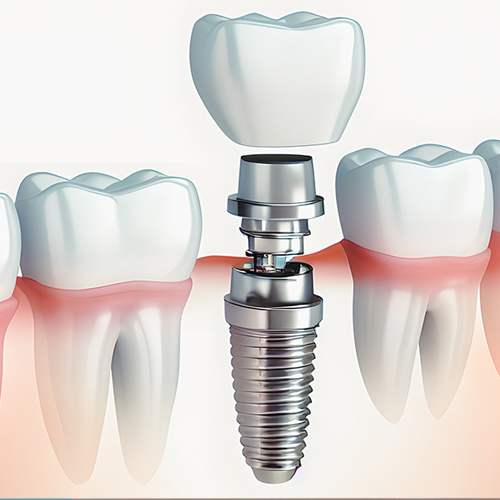Dental implants are a revolutionary solution for replacing missing teeth, offering a long-lasting, natural-looking, and functional alternative to traditional dentures and bridges. In this comprehensive guide, we’ll explore what dental implants are, the benefits, the procedure, and what to expect before, during, and after the implant process.
What are Dental Implants?
Dental implants are artificial tooth roots made of biocompatible materials, such as titanium, that are surgically placed into the jawbone. They provide a stable foundation for fixed or removable replacement teeth, such as crowns, bridges, or dentures. Dental implants mimic the look, feel, and function of natural teeth.
Key Components of a Dental Implant:
- Implant Post: The titanium screw that is surgically inserted into the jawbone, acting as the tooth root.
- Abutment: The connector placed on top of the implant post that holds the replacement tooth or teeth.
- Prosthesis: The visible part of the replacement tooth, such as a crown, bridge, or denture, that is attached to the abutment.
Benefits of Dental Implants
- Natural Appearance: Implants look and feel like natural teeth, providing a seamless appearance.
- Improved Function: They restore full chewing and speaking abilities.
- Durability: With proper care, dental implants can last a lifetime.
- Bone Health: Implants help prevent bone loss and preserve facial structure.
- Stability: Unlike dentures, implants do not slip or move, providing a secure fit.
- Convenience: No need for adhesives or special cleaning routines.
The Dental Implant Procedure
The dental implant process involves several key stages:
-
Consultation and Evaluation
- Assessment: Your dentist will assess your oral health, take dental impressions, and perform imaging studies like X-rays or CT scans to evaluate bone density and structure.
- Planning: A personalized treatment plan is developed based on your dental health, the number of teeth to be replaced, and your aesthetic goals.
-
Preparation
- Pre-Surgery Care: You may need to follow specific pre-surgery instructions, such as avoiding certain medications or fasting.
- Bone Grafting: If you lack sufficient bone density, a bone graft may be performed to provide a stable foundation for the implant.
-
Implant Placement
- Anesthesia: Local anesthesia or sedation is used to ensure comfort during the procedure.
- Surgery: The dentist or oral surgeon makes an incision in the gum to expose the jawbone, drills a hole, and places the implant post into the bone.
- Healing: The gum is closed over the implant, and a healing period of several months is required for osseointegration, where the implant fuses with the bone.
-
Abutment Placement
- Exposure: Once osseointegration is complete, the implant is exposed, and the abutment is attached.
- Healing Cap: A healing cap may be placed on the abutment to allow the gum tissue to heal around it.
-
Prosthesis Placement
- Impressions: Dental impressions are taken to create the custom prosthesis (crown, bridge, or denture).
- Fitting: The prosthesis is attached to the abutment, and adjustments are made to ensure a proper fit and bite.
Recovery and Aftercare
-
Initial Recovery
- Discomfort: Mild discomfort, swelling, and bruising are common after surgery and can be managed with prescribed pain medications and ice packs.
- Diet: A soft diet is recommended for the first few days to avoid disturbing the surgical site.
-
Oral Hygiene
- Cleaning: Maintain good oral hygiene by brushing and flossing regularly. Your dentist may recommend special cleaning tools for implants.
- Check-ups: Regular dental check-ups and cleanings are crucial to monitor the health of the implants and surrounding tissues.
-
Long-Term Care
- Lifestyle: Avoid habits that can damage implants, such as smoking and chewing hard objects.
- Monitoring: Attend all follow-up appointments to ensure the implants are functioning properly and the surrounding bone and gum tissue are healthy.
Benefits of Dental Implants
- Enhanced Aesthetics: Achieves a more attractive and balanced smile.
- Improved Function: Restores full chewing and speaking abilities.
- Durability: Implants are designed to last a lifetime with proper care.
- Bone Health: Helps preserve jawbone density and facial structure.
- Stability: Provides a secure and stable fit, unlike dentures.
- Convenience: No need for adhesives or special cleaning routines.
Risks and Considerations
As with any surgical procedure, dental implants carry some risks, including:
- Infection: Infection at the implant site is possible but can be managed with proper care and antibiotics.
- Implant Failure: In rare cases, the implant may not integrate with the bone and may need to be removed.
- Nerve Damage: Nerve injury can cause numbness or tingling in the gums, lips, or chin.
- Sinus Issues: Implants in the upper jaw can protrude into the sinus cavity, causing issues.
Choosing a skilled and experienced dentist or oral surgeon is crucial to minimizing these risks and achieving the best possible outcome.


